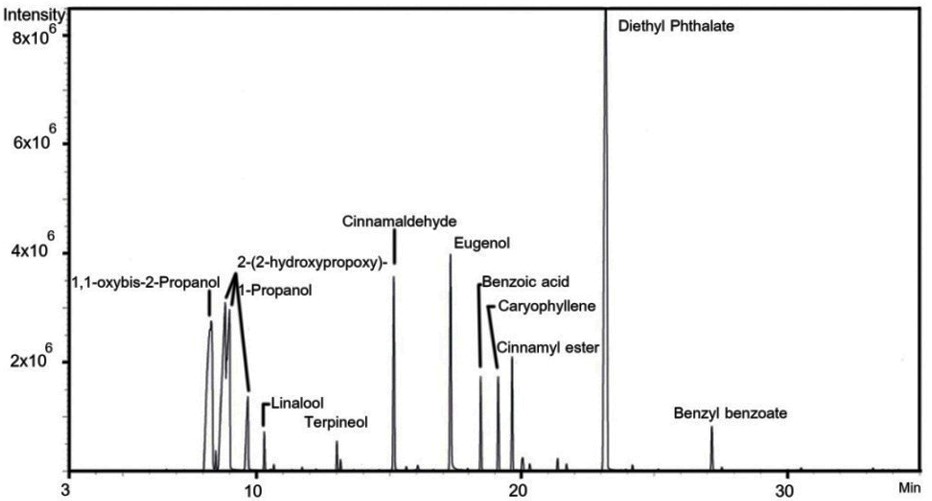ประสิทธิภาพของน้ำมันหอมระเหยทางการค้าต่อการยับยั้งการเจริญของเชื้อแบคทีเรียก่อโรค
Main Article Content
Abstract
Thippayarat Chahomchuen and Wimonrut Insuan
รับบทความ: 5 เมษายน 2561; แก้ไขบทความ: 8 สิงหาคม 2561; ยอมรับตีพิมพ์: 24 ตุลาคม 2561
บทคัดย่อ
งานวิจัยนี้มีจุดประสงค์เพื่อศึกษาประสิทธิภาพของน้ำมันหอมระเหยกานพลู ตะไคร้บ้าน และอบเชยที่มีขายในเชิงพาณิชย์ในการต้านแบคทีเรียก่อโรค 4 ชนิด ได้แก่ Bacillus subtilis Escherichia coli Staphylococcus aureus และ Pseudomonas aeruginosa ด้วยวิธี broth dilution method พบว่าน้ำมันหอมระเหยกานพลูมีประสิทธิภาพในการยับยั้งการเจริญของเชื้อทดสอบได้ดีที่สุดโดยมีความเข้มข้นต่ำสุดในการยับยั้งเชื้อแบคทีเรีย (minimum inhibitory concentration, MIC) ต่อ B. subtilis E. coli S. aureus และ P. aeruginosa เท่ากับร้อยละ 0.125 0.25 0.25 และ 1.0 (โดยปริมาตร) ตามลำดับ และมีประสิทธิภาพในการกำจัดแบคทีเรียที่ความเข้มข้นต่ำสุด (minimum bactericidal concentration, MBC) เท่ากับร้อยละ 0.5 1.0 0.5 และ 2.0 ตามลำดับ น้ำมันหอมระเหยตะไคร้บ้านสามารถยับยั้งการเจริญของ E. coli ได้ดีที่สุด รองลงมาคือ B. subtilis S. aureus และ P. aeruginosa โดยมีค่า MIC เท่ากับร้อยละ 0.062 0.125 0.125 และ 2.0 ตามลำดับ และมีค่า MBC ต่อ B. subtilis, S. aureus และ E. coli เท่ากันคือ ร้อยละ 0.25 น้ำมันหอมระเหยอบเชยมีค่า MIC ต่อ B. subtilis และ S. aureus เท่ากับร้อยละ 1.0 ต่อ E. coli และ P. aeruginosa เท่ากับร้อยละ 2.0 (โดยปริมาตร) มีค่า MBC ต่อ B. subtilis S. aureus และ E. coli เท่ากับร้อยละ 2.0 จากผลการศึกษาแสดงให้เห็นว่าน้ำมันหอมระเหยกานพลูอบเชยและตะไคร้บ้าน สามารถยับยั้งการเจริญของเชื้อแบคทีเรียทั้ง 4 ชนิดได้ การทดสอบฤทธิ์ต้านอนุมูลอิสระด้วยวิธี DPPH scavenging assay พบว่า น้ำมันหอมระเหยกานพลูมีฤทธิ์ต้านอนุมูลอิสระสูงกว่าน้ำมันหอมระเหยอบเชย ไม่พบฤทธิ์ต้านอนุมูลอิสระของน้ำมันหอมระเหยตะไคร้บ้าน เมื่อหาองค์ประกอบโดยวิธี GC–MS องค์ประกอบหลักในน้ำมันหอมระเหยกานพลูคือ eugenol น้ำมันหอมระเหยตะไคร้บ้านคือ citral และในน้ำมันหอมระเหยอบเชยคือ eugenol และ cinnamondehyde
คำสำคัญ: น้ำมันหอมระเหย ฤทธิ์ต้านแบคทีเรีย แบคทีเรียก่อโรค
Abstract
This research aimed to study on the efficacy of commercial essential oil including clove oil, lemongrass oil and cinnamon oil for inhibition the growth of four pathogenic bacteria as Bacillus subtilis, Escherichia coli, Staphylococcus aureus and Pseudomonas aeruginosa. The results from broth dilution method found that clove oil was the most effective in inhibiting the growth of B. subtilis, E. coli, S. aureus and P. aeruginosa with the minimum inhibitory concentration (MIC) of 0.125, 0.25, 0.25 and 1.0%(v/v) respectively and the minimum bactericidal concentration (MBC) values of 0.5, 1.0, 0.5 and 2.0%(v/v), respectively. E. coli was the most sensitive bacteria against lemongrass oil, followed by B. subtilis S. aureus and P. aeruginosa with the MIC of 0.062, 0.125, 0.125 and 2.0%(v/v). The MBC of B. subtilis, S. aureus and E. coli was 0.25%(v/v). Cinnamon oil showed the MIC values at 1.0%(v/v) against B. subtilis and S. aureus, and 2.0%(v/v) against E. coli and P. aeruginosa. Cinnamon oil was able to kill B. subtilis, S. aureus and E. coli with the MBC of 2.0%(v/v). These results indicated that clove oil, lemongrass oil and cinnamon oil had the potential antibacterial activity against 4 pathogenic bacteria. Antioxidant activity by DPPH scavenging assay of clove oil exhibited higher activity than cinnamon oil. No antioxidant activity of lemongrass oil was detected. The components of essential oils were analyzed by GC-MS and the results showed eugenol was the major compound in clove oil, citral in lemongrass oil, eugenol and cinnamondehyde in cinnamon oil.
Keywords: Essential oil, Antibacterial activity, Pathogenic bacteria
Downloads
Article Details

This work is licensed under a Creative Commons Attribution-NonCommercial 4.0 International License.
References
Algburi, A., Comito, N.,Kashtanov, D., Dicks, L. M. T., and Chikindas,M. L. (2017). Control of biofilm formation: antibiotic and boyond. Applied and Environmental Microbiology 83(6): e00165–e00117.
Bajpai, V. K., Sharma, A., and Baek, K. H. (2014). Antibacterial mode of action of the essential oil obtained from Chamaecyparis obtusesawdust on the membrane integrity of selected foodborne pathogens. Food technology and Biotechnology 52(1): 109–118.
Burt, S. (2004). Essential oils: Their antibacterial properties and potential applications in foods – A review. International Journal of Food Microbiology 94(3): 223–253.
Cheel, J., Theoduloz, Rodriguez, C. J., and Schmeda–Hirschmann, G.(2005). Free radical scavengers andantioxidants from lemongrass [Cymbopogon citratus (DC.) Stapf.]. Journal of Agricultural and Food Chemistry 53(7):2511–2517.
Choi, O., Cho, S. K., Kim, J. Park, C. G., and Kim, J. (2016). In vitro antibacterial activity and major bioactive components of Cinnamomum verum essential oils against cariogenic bacteria, Streptococcus mutans and Streptococcus sorbrinus. Asian Pacific Journal of Tropical Biomedicine 6(4): 308–314.
de Almeida Silva, K. C. F., Calomino, M. A., Devtsch, G.,de Castilho, S. R.,de Paula, G. R., Esper, L. M. R.,and Teixeira,L. A. (2017). Molecular characterization of multi drug–resistant (MDR) Pseudomonas aeruginosa isolated in a burn center. BURNS 43(1): 137–143.
Dussault, D., Vu, K. D., and Lacroix, M. (2014). In vitro evaluation of antimicrobial activities of various commercial essential oils, oleo-resin and pure compounds against food pathogens and application in ham. Meat Science 96(1): 514–520.
Ha, H. K. P., Maridable, J., Gaspillo, P., Hasika, M., Malaluan, R. and Kawasaki, J. (2008). Essential oil from lemongrass extracted by supercritical carbon dioxide. The Philippine Agricultural Scientist 91(1): 36–41.
Hammer, K.A, Carson, C. F., and Riley, T. V. (1999). Antimicrobial activity of essential oils and other plant extracts. Journal of Applied Microbiology 86(6): 985–990.
Inouye, S., Takizawa, T., and Yamaguchi, H. (2001). Antibacterial activity of essential oils and their major constituents against respiratory tract pathogens by gaseous contact. Journal of Antimicrobial Chemotherapy 47(5): 565-573.
Jongjeen, J. 2012. Efficiency of essential oils from medicinal plants for inhibition of fungal causing spoilage in bread. Agricultural Science Journal 43(2)(Supplement): 145–148. (in Thai)
Kavanaugh, N.L., and Ribbeck, K.(2012). Selected antimicrobial essential oils eradicate Pseudomonas spp. and Staphylococcus aureus biofilms. Applied and Environmental Microbiology 78(11): 4057– 4061.
Quave, C. L., Plano, L. R. W., Pantuso, T. and Bennett, B. C.(2008). Effects of ex-tracts from Italian medicinal plants on planktonic growth, biofilm formation and adherence of methicillin–resistant Staphylococcus aureus. Journal of Ethnopharmacology 118(3): 418–428.
Sirvaityte, J., Siugzdaite, J., and Valeika, V. (2011). Application of commercial essential oils of eucalyptus and lavender as natural preservative for leather tanning industry. Revista de Chimie (Bucharest) 62(9): 8848–893.
Woodford, N., and Livermore,D. M. (2009). Infections caused by gram–positive bacteria: A review of the global challenge. Journal of Infection 59 (Supplement 1): S4–S16.
(บทความออนไลน์นี้มีการแก้ไขเพิ่มเติมตาราง 3 เพื่อให้เกิดความสมบูรณ์ของบทความและเกิดประโยชน์สูงสุดกับผู้อ่านบทความเพื่อนำไปใช้งาน)
